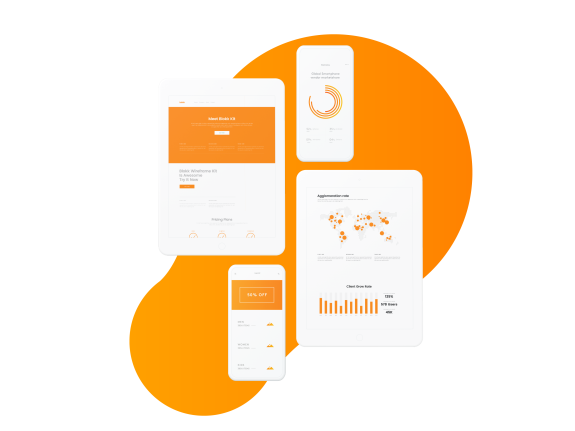Innovate solutions at scale
No more building from scratch
Pre-built microservice applications along with object-based content functions make building solutions rapid and repeatable.
Perfect DevOps environment
Deploy and change designs and content with Bitbucket, GIT or any other distributed version control system.
No front-end limitations
Create any design using any front-end framework and build complex web properties with HTML, CSS, and JavaScript.
Never re-platform again
With regular updates for new features, upgrades and updates a year, you can build an integrated solution with peace of mind.
Enjoy the seamless updates without any disruption
Core dna is never versioned, so as you grow, Core dna grows with you. The platform is updated and gets better every day without interruption to your service.
Hands-free management
Core dna removes the need to install patches or plugins, or worry about scaling and securing infrastructure. Our dedicated team handles the back-end technology management.

The complete system to deliver digital solutions for your stakeholders

SaaS multi-tenant architecture
Enterprise technology platform. Built to scale and grow with your business.

Enterprise hybrid hosting
Best-in-class architecture that frees you up from managing servers and delivers content seamlessly.

Pre-built industry solutions
Ready-to-use applications. Low code, just add your design. With all the updates and new features included.

Industry-standard version control
Advanced change control process with cloud-based development environments, multiple staging, and production environments.

Rapid deployment
Using our pre-built applications to create complex, highly dynamic, and personalized website solutions.

Future-proof your technology
Advanced functionality that is ready-to-use. New features and patches are applied weekly.

Headless architecture
Leverage our platform APIs and decoupled architecture to create applications that deliver your content anywhere.

Integrate with other systems
Use our webhooks feature to connect with other systems and exchange information seamlessly.

Design freedom
Our platform supports all major web user interface frameworks allowing you to create personalized set of reusable UI components.

Set permissions for greater control
Manage access and workflows
Empower regional groups while maintaining control over corporate data.
Fewer calls for help
Reduce the burden of constant help tickets thanks to content control features and front-end layout control.
Multiple agency resources on a single platform
Have your marketing agency deploy landing pages, while your front-end partner is rolling out new design features.
Development insights
All web development insightsFrequently asked questions
Is Core dna Open sourced Software?
No, we’re not an open-source platform. Our platform is delivered as a SaaS Digital Experience Platform (DXP). It operates as a closed-source Digital Experience Platform (DXP) with a SaaS business model. Unlike open source platforms where code is freely available and modifiable, Core dna maintains controlled access to its source code, provides managed hosting, centralized updates, and professional support through a commercial subscription model.
This approach ensures enterprise-grade security, stability, and dedicated support, though it means customizations must occur within the platform's established framework rather than through direct code modification.
How is Core dna different?
Core dna is a proprietary Digital Experience Platform (DXP) that unifies content management, ecommerce, intranets, and marketing capabilities into a comprehensive business solution. As a SaaS platform, it differs from open-source alternatives by providing a fully managed, secure environment where all components are professionally maintained and regularly updated.
The platform integrates multiple digital experience tools:
- Content Management System (CMS) for website and digital content
- Ecommerce functionality for online stores and transactions
- Intranet capabilities for internal communication
- Marketing automation tools for customer engagement
- Analytics and reporting features
Key technical aspects:
Platform Architecture
1. Microservices-based design: An architecture where applications are built as a collection of small, independent services that communicate over APIs, enabling flexibility and scalability.
2. Scalable cloud infrastructure: A cloud environment designed to automatically handle increased workloads by dynamically allocating resources.
3. Built-in redundancy and failover: Systems designed with duplicate components and automatic switching mechanisms to ensure high availability during failures.
4. Containerized applications: Software packaged with its dependencies into isolated containers, ensuring consistent performance across environments.
5. Load-balanced environment: A setup where traffic is distributed evenly across multiple servers to optimize performance and prevent overload.
Security Framework
1.SOC 2 Type II compliance: A certification ensuring an organization meets rigorous standards for data security, availability, processing integrity, confidentiality, and privacy over time.
2.End-to-end encryption: A security measure that ensures data is encrypted during transmission and only decrypted by the intended recipient.
3.Regular security audits: Periodic reviews and assessments of systems and processes to identify and mitigate security vulnerabilities.
4.Automated threat detection: Systems that use AI and algorithms to continuously monitor and identify potential security threats in real time.
5.Multi-factor authentication: A security method requiring multiple forms of verification to confirm a user’s identity.
Platform Updates
1.Continuous deployment pipeline: An automated process that ensures code changes are tested, validated, and deployed to production seamlessly.
2.Zero-downtime updates: A deployment strategy that enables application updates without interrupting user access or service availability.
3.Automated testing: A process of running predefined tests automatically to verify code quality and functionality during development.
4.Version control: A system that tracks changes to code, allowing developers to collaborate, manage revisions, and roll back if needed.
5.Feature flags for controlled rollouts: A technique to toggle specific features on or off, enabling gradual or targeted releases without full deployments.
Support Structure
- 24/7 technical assistance
- Dedicated success managers
- Developer documentation
- Training resources
- Community forums
This enterprise-grade platform serves mid to large-sized organizations requiring robust digital experience solutions without the complexity of managing open-source infrastructure.
Core dna is designed on open, component-based architecture to be a flexible environment that can be easily managed. The architecture supports a range of operations and has been tested on both Unix and Windows based platforms. This helps to reduce problems that can arise from different operating systems and allows flexibility during deployment. The presentation layer supports an interaction with the business logic through the services layer. It allows the flexibility for each of our clients to control the look and feel of their website as well as the functional modules they wish to deliver.
The technology is built on the scaleable technology stack. Linux base operating system, Apache HTTPd web server, MariaDB database layer and PHP development language. The front end stack is agnostic and we have developed solutions using a variety of front end frameworks including Bootstrap, Foundation, UI kit, AngularJS, React.
Core dna is a hosted platform, a true multi-tenant, single instance SaaS solution.








